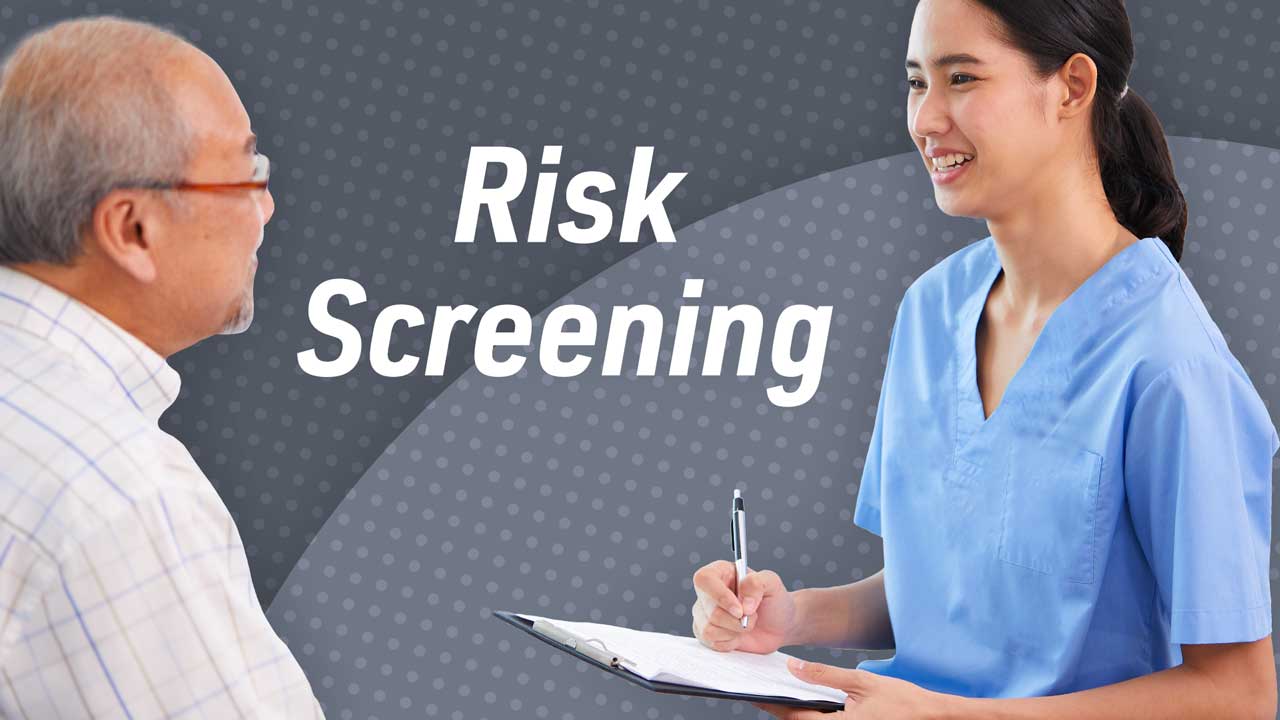Risk screening can assist in the early detection of potential harm to clients and ensure that care is delivered safely, effectively and appropriately (Health.vic 2015, 2022).
It’s important to differentiate risk screening from other similar processes, including risk assessment and diagnostic testing.
What is Risk Screening?
Risk screening is the process of identifying clients who may be at risk of harm and then minimising any risks that have been recognised (ACSQHC 2018).
Unlike risk assessment, risk screening is a shorter and less complex process. Risk assessment may be performed after risk screening if deemed necessary (ACSQHC 2018).
It is also important to differentiate between risk screening and diagnostic testing. While diagnostic testing is performed in order to identify the cause of specific symptoms being experienced by the client, risk screening may be performed even if the client is feeling well in order to identify a risk of injury or disease or an injury or disease in its early stages (IQWiG 2019; ACSQHC 2018).
Generally, risk screening is used as a starting point to determine whether any further or more detailed assessments would be beneficial for the client (Health.vic 2015).
Risk screening should be performed upon admission in order to establish a baseline for the client’s health. Ideally, it will then continue to be performed regularly and when required throughout the client’s care (Health.vic 2022).
The aim of risk screening is to:
- Identify whether there is any risk of harm or poor health outcomes, and the extent to which the client is at risk
- Inform the decision-making process in order to address any identified risks through assessment, risk mitigation interventions and escalation of care
- Develop a comprehensive care plan alongside the client.
(ACSQHC 2019)
Risk Screening in the National Safety and Quality Health Service Standards
Risk screening is outlined in Action 5.10 of the National Safety and Quality Health Service Standards, under Standard 5: Comprehensive Care.
This action aims to ensure that all clients receive initial risk screening upon presentation and that this is repeated when necessary (ACSQHC 2023).
Health service organisations are required to:
- Perform risk screening upon presentation, during clinical examination and history taking, and whenever else required
- Screen for cognitive, behavioural, mental and physical conditions, issues or risks of harm
- Determine whether there are any other circumstances (e.g. social) that may worsen identified risks.
(ACSQHC 2023)
What is Risk Screening Used for?

There are a variety of cognitive, behavioural, mental and physical conditions, issues and risks that can be screened in healthcare, including (ACSQHC 2023):
- Clinical issues
- Falls
- Pressure injuries
- Cognitive impairment
- Malnutrition
- Self-harm and suicide
- Violence and aggression.
(ACSQHC 2018)
How is Risk Screening Performed?
Risk screening may be conducted in several ways, depending on the client and the specific risk(s) being screened for.
Medical tests may be used to screen for physical abnormalities, for example, a stool test to assess for the presence of blood. These tests are often unable to diagnose the client and require a follow-up assessment if abnormalities are detected (IQWiG 2019).
Short integrated screening tools generally comprise a series of closed questions for the client to answer. These tools are used to determine whether there are any risks or vulnerabilities that the client may be susceptible to. It’s important to ensure that any tools used have been validated for the client’s population (ACSQHC 2018).
Validated single risk assessment tools are used to assess whether the client is at risk of specific harm (e.g. falls, pressure injury). These are more detailed than short integrated screening tools (ACSQHC 2018).
Screening discussions involve initiating a purposeful, person-centred conversation with the client. Discussions can help you to determine the client’s baseline, as well as identify any potential risks. This approach may be useful for triaging clients to determine who requires further action and how immediately. Discussions can be initiated during other activities and assessments such as handover (ACSQHC 2018).
In order to ensure discussions are person-centred, it is important to:
- Determine whether an interpreter is required
- Determine who is responsible for performing the screening
- Ensure appropriate introductions have been made
- Determine an appropriate sequence of questions
- Determine whether any answers require input from carers or other staff
- Obtain all required consent.
(ACSQHC 2018)

The following table outlines some discussion areas to address with the client, along with the potential risks to assess for:
| Discussion area | Possible risks to assess for |
|---|---|
| Whether the client is an Aboriginal or Torres Strait Islander person |
|
| Reason for presentation to healthcare |
|
| Client’s current situation |
|
| Wellness prior to presentation |
|
| Client’s usual living arrangements |
|
| How far the client can walk |
|
| Client’s capacity to manage finances, bills etc. on their own |
|
| Nutritional intake and diet |
|
| Medications (how many, what they are and what they are used for) |
|
| History of alcohol, tobacco, recreational drugs, herbal and alternative medicines |
|
| Issues at home causing worry or concern |
|
| History of healthcare-associated infection (HAI) |
(ACSQHC 2018)
Issues and Limitations Associated With Risk Screening
While risk screening can be a useful and valuable method of identifying potential risks, there are some issues and limitations that have been identified. It is important to keep these in mind when screening clients.
- Risk screening is generally unable to prevent illness unless risk factors can be influenced, or abnormal changes can be identified and treated before they develop into an illness. Furthermore, these treatments may ultimately be unnecessary, as abnormal changes do not always result in illness and may disappear on their own.
- In some cases, the client may not benefit from early detection of an illness if there is no treatment that is more effective when started early.
- Some types of risk screening are potentially harmful to the client (e.g. x-rays exposing the client to radiation).
- Some risk areas such as falls and pressure injuries have several screening tools available, but no single gold-standard tool.
- Some integrated risk screening tools have only been validated and tested in older adults.
- Some risk screening tools require specific training.
- The way in which risk screening is performed (how it is performed, who performs it, which tools are used etc.) can vary significantly, even within the same health service organisation.
- There may be a lack of differentiation between risk screening and risk assessment.
- Staff may have varying levels of confidence in risk screening tools, with some preferring to use clinical judgement alone.
- Risk screening may increase the workload for staff.
- Repeated screening may cause clients to become confused and frustrated.
- There is limited evidence that patient outcomes are improved by current risk screening measures.
(IQWiG 2019; ACSQHC 2018)
Conclusion
Risk screening can be used to establish a client’s baseline health and identify any potential risk factors. However, it is important to be aware of the limitations to this process.
Note: This article is intended as a refresher and should not replace best-practice care. Always refer to your organisation's policy on risk screening.
Test Your Knowledge
Question 1 of 3
True or false: Risk assessment takes longer and is more complex than risk screening.
Topics
References
- Australian Commission on Safety and Quality in Health Care 2023, Action 5.10: Screening of Risk, Australian Government, viewed 2 October 2023, https://www.safetyandquality.gov.au/standards/nsqhs-standards/comprehensive-care-standard/developing-comprehensive-care-plan/action-510
- Australian Commission on Safety and Quality in Health Care 2019, Comprehensive Care: Element 3 Risk Screening and Assessment, Australian Government, viewed 2 October 2023, https://www.safetyandquality.gov.au/sites/default/files/2019-09/cc_factsheet_e3_risk_screening_and_assessment_for_clinicians_sep_2019.pdf
- Australian Commission on Safety and Quality in Health Care 2018, Implementing the Comprehensive Care Standard: Approaches to Person-Centred Screening, Australian Government, viewed 2 October 2023, https://www.safetyandquality.gov.au/sites/default/files/migrated/Implementing-Comprehensive-Care-Approaches-to-person-centred-risk-screening-Accessibility-PDF.pdf
- Institute for Quality and Efficiency in Health Care 2019, Benefits and Risks of Screening Tests, InformedHealth.org, viewed 2 October 2023, https://www.ncbi.nlm.nih.gov/books/NBK279418/
- Health.vic 2015, Assessment and Ageing, Victoria State Government, viewed 2 October 2023, https://www2.health.vic.gov.au/hospitals-and-health-services/patient-care/older-people/comm-topics/assessment/assessment-ageing
- Health.vic 2022, Screening, Victoria State Government, viewed 2 October 2023, https://www2.health.vic.gov.au/hospitals-and-health-services/patient-care/older-people/comm-topics/assessment/assessment-screening
 New
New 
